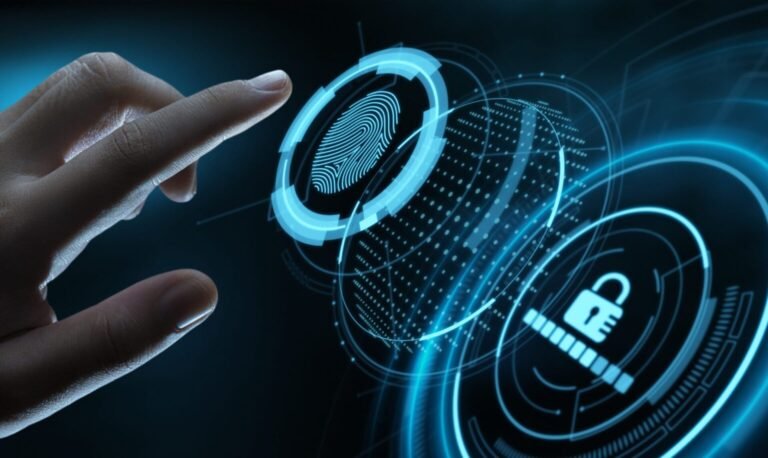Biometrics is rapidly transforming the landscape of security, offering advanced solutions to traditional challenges in identification and authentication. From facial recognition to fingerprint scanners, biometric authentication systems: face scanners, location tracking, and security in banking and mobile devices have become an integral part of both physical and digital security. In this blog post, we’ll dive deep into the world of biometric security systems, biometric authentication, and how they are changing industries such as banking, mobile devices, and beyond.
What is a Biometric Entry System?
A biometric entry system is a security technology that uses biological traits—like fingerprints, facial features, or even eye scans—to grant access to secure locations. Unlike traditional methods, such as keycards or passwords, biometrics ensures that access is only granted to those who are physically present, offering an added layer of protection. These systems are already widely used in high-security areas such as government buildings, data centers, and airports, where unauthorized access could have catastrophic consequences.
Biometric Location Tracking: Keeping You Safe
Biometric location tracking takes security to the next level by combining identity verification with real-time location data. This technology allows companies to track individuals based on their biometric information while also monitoring their whereabouts. For instance, in large organizations, biometric location tracking can help monitor employee movement, ensuring that sensitive areas are only accessed by authorized personnel.
It’s not just for businesses; law enforcement agencies are increasingly using biometric tracking to solve crimes and track suspects, making it a vital tool in the fight against crime and terrorism.
Biological Scanners: The Heart of Biometric Systems
The biological scanner plays a crucial role in biometric identification. These scanners analyze unique biological traits—whether a fingerprint, face shape, or even an iris scan—to verify someone’s identity. As technology advances, these scanners are becoming more accurate and less intrusive, ensuring that both security and privacy are upheld.
The Role of Biometric Face Scanners
One of the most well-known applications of biometric technology is the biometric face scanner. Face recognition systems are already in place in smartphones, airports, and secure office buildings. These scanners map out key features of a person’s face and use them for verification purposes.
The best part? Biometric face scanners are fast, non-intrusive, and highly accurate. It’s no wonder that facial recognition technology is projected to become a dominant form of biometric authentication in the coming years.
Biometrics in Banking: A New Era of Financial Security
The biometrics in banking sector has seen major advancements in recent years. Many banks are adopting biometric authentication methods to streamline and secure the process of logging into accounts, making payments, and authorizing transactions. Biometric authentication for mobile devices is one of the most popular trends here, allowing users to access their bank accounts with just a fingerprint or a face scan.
This technology significantly reduces the risk of fraud, offering both convenience and peace of mind to users. In fact, with biometric identity verification systems, sensitive financial data is now more secure than ever.
Biometric Shapes: Unlocking New Forms of Identification
While most of us are familiar with fingerprints or facial recognition, there are biometric shapes that offer new possibilities in identification. These unique identifiers, such as palm or ear shapes, are now being explored as reliable options for biometric identification. Though still in the experimental phase, these biometric shapes could soon become a mainstream method for securing both physical and digital spaces.
Robots, Biometrics, and Security: A Complex Relationship
With the increasing adoption of robots in industries, the role of robotics in biometric security systems has become a topic of debate. On the one hand, robots can automate biometric processes, improving efficiency in areas like facial recognition or fingerprint scanning. On the other hand, the demerits of robots in security are also being scrutinized, as robots can potentially make mistakes or be hacked.
The advantages and disadvantages of robots in biometric security systems show us that while robots can enhance security, they can also introduce vulnerabilities that need to be addressed carefully.
The Advantages of Robots in Biometric Systems
Despite the disadvantages of robots, their integration with biometric systems can lead to significant improvements. Robots, equipped with biometric tracking capabilities, can process large volumes of data quickly, reducing the margin for error in systems like facial recognition or fingerprint authentication. Furthermore, robots can be deployed in various industries—such as healthcare or law enforcement—to enhance the efficiency and accuracy of biometric identity verification systems.
Which Biometric Authentication Methods Are Used?
There are several methods used for biometric authentication, each catering to different needs and security requirements. Some of the most common include:
- Fingerprint scanning: Often used for entry systems and mobile devices.
- Face recognition: Popular in smartphones and surveillance systems.
- Iris scanning and voice recognition: More specialized, but highly secure forms of authentication.
As technology evolves, new biometric methods, such as biometric shapes (like palm or ear recognition), may soon join the ranks of these common systems.
Biometrics & Security: The Future is Now
The future of biometrics holds great promise, particularly in the realm of biometrics and security. With advancements in AI, machine learning, and sensor technology, biometric systems are becoming more sophisticated, accurate, and secure. These technologies are not only changing the way we authenticate identity, but also redefining what security means in the 21st century.
The biometric identity verification system is likely to become a cornerstone of digital security in the years to come, offering a seamless and highly secure way to access everything from smartphones to bank accounts.
Conclusion: Embracing the Power of Biometrics
From biometric face scanners to the growing use of robots in security, the potential of biometrics is undeniable. As technology continues to evolve, we can expect even more innovative solutions to emerge, offering unparalleled security, efficiency, and convenience. As we look to the future, it’s clear that biometrics will play a pivotal role in shaping the security systems of tomorrow.
By adopting and integrating biometric technologies, we can create a safer, more secure world for all.
